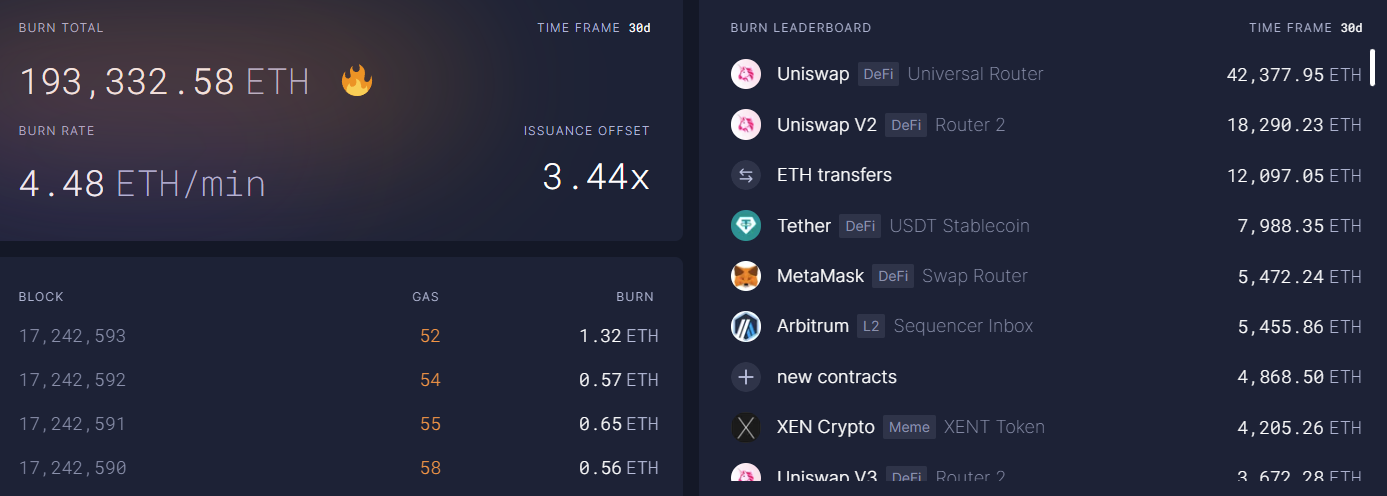Since the implementation of the EIP1559 upgrade and the transition to the Proof of Stake consensus protocol, a significant portion of Ethereum transaction fees are permanently destroyed or "burned." This feature makes the native asset Ether (ETH) an attractive deflationary investment, according to Goldman Sachs.
Ether (ETH) is the digital asset that powers and secures the Ethereum protocol. As the second-largest cryptocurrency by market capitalization, it serves as a means of executing transactions and interacting with self-executing applications (smart contracts). Users pay transaction fees in Ether for these purposes, which are distributed to validators (stakers) and a portion is sent to a "burn address." During periods of high network activity, the burning of these transaction fees can surpass the inflation of Ether, as outlined in a note by the banking giant Goldman Sachs.
Drastic changes to the Ether tokenomics
The Ethereum network was launched on July 30, 2015, with an initial supply of 72 million coins for its native asset, Ether. Unlike Bitcoin, Ether does not have a fixed inflation rate; instead, its issuance follows a variable annual rate known as the "inflation plan." Over the past eight years, the circulating supply of Ether has increased to nearly 120 million coins. The two most significant changes to this inflation plan came through two network upgrades: the London Hard Fork (EIP1559) and the Merge.
The London Hard Fork (EIP1559) modified the fee mechanism on Ethereum, introducing a base fee and an optional priority fee (or tip) for validators. The base fee is burned, while validators receive the priority fee and block rewards. The burning of this base fee effectively reduces the net Ether inflation. However, the mechanism is highly dependent on the activity of the Ethereum network: the more activity on the chain, the more Ether is burned. EIP1559 is barely noticeable during periods of low network activity.
The second change to the Ether token model was part of Ethereum's transition from Proof of Work to Proof of Stake, known as the Merge. The new consensus protocol reduced the inflationary selling pressure on Ether in two ways. Firstly, the block rewards were reduced from 13,000 to 1,700 ETH per day, resulting in an 85% decrease in inflation. Additionally, miners providing computational power for block validation were replaced by validators/stakers, who must stake a certain amount of Ether instead of consuming energy. The inflation in the form of block rewards now goes to actors with skin in the game. Since the Merge, this deflationary combination has led to a reduction in supply by 221,000 Ether (approximately $390 million).

Memecoins drive deflationary pressure on Ether
The recent resurgence of memecoins has been responsible for accelerating Ether inflation. Memecoins, typically created as jokes and primarily used for speculation, reside primarily on the Ethereum blockchain, requiring Ether as gas fees for transaction settlements. The rapid increase in memecoin activity, as seen in the emergence of tokens like Pepe (PEPE) in recent weeks, has a deflationary impact on the supply of Ether.

In the past 30 days alone, the smart contract of the leading decentralized trading protocol Uniswap has burned 112 million Ether. This, combined with the additional benefit of passive returns through staking, enhances the attractiveness of Ether as an investment over the long term. By comparison, Bitcoin's inflation rate stands at approximately 1.8% annually until the next halving event in 2024.








